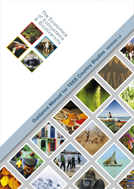 The Guidance Manual for TEEB Country Studies provides both technical and operational guidance on how countries may conduct a TEEB Country Study. It outlines the various steps that may be taken to initiate and implement a country study, communicate its findings, and implement the recommendations of the study.
The Guidance Manual for TEEB Country Studies provides both technical and operational guidance on how countries may conduct a TEEB Country Study. It outlines the various steps that may be taken to initiate and implement a country study, communicate its findings, and implement the recommendations of the study.
The target audience of this manual is researchers and decision-makers at the national or sub-national level considering or currently undertaking a TEEB country study (TCS). Its purpose is to provide guidance throughout the entire TCS cycle i.e., from initiation, to policy analysis and ecosystem service valuations, communicating findings, following up and finally applying results.
The manual is not intended to be prescriptive but rather provides directions and guidelines for TEEB implementation, which must be adapted according to the specific circumstances and objectives of the country. It also outlines the quality and completeness criteria for such a study to become formally endorsed as a “TEEB Country Study” by the TEEB Advisory Board.
The manual was developed by the Helmholtz Centre for Environmental Research (UFZ), UNEP, Deutsche Gesellschaft fuer Internationale Zusammenarbeit (GIZ) and the Institute for European Environmental Policy (IEEP) and was launched during the Trondheim Conference on Biodiversity on 28 May 2013.
Download Guidance Manual (English) - PDF
Suggested citation: The Economics of Ecosystems and Biodiversity (TEEB) (2013). Guidance Manual for TEEB Country Studies. Geneva: United Nations Environment Programme.
Chapter summaries
Chapter 1 – Introduction: What is TEEB and how does it integrate into the policy landscape?
This introduction aims to make sure you understand the concept of TEEB and the motivations of adding an economic perspective to the debate on biodiversity, before beginning a TEEB country study (TCS). This chapter will enable the reader to discuss and identify the added value of a TEEB study in his/her country and to get an overview of on-going related policy initiatives.
Chapter 2 – How to select the scope and objectives of the TEEB Country Study and how to set up the process?
After an overview of expected outputs of the scoping phase (Section 2.1), this chapter provides information on how to identify the highest priority concerns and determine focus areas and objectives (Section 2.2); how to set up the process of conducting a TEEB country study and its governance structure (Section 2.3); and how to identify and bring on board the relevant stakeholders (Section 2.4).
Chapter 3 – Main study phase
The findings of scoping results are the departure point for the main study phase. Based on these, terms of reference can be designed which can help to orient the formation of study teams on the different aspects identified as relevant. Guidance presented here on the main study phase is provided largely along the TEEB six-step approach. These steps are important to apply but need not all necessarily be applied in the order presented or to the same level of detail. This reflects the uniqueness of each decision-making context along with differences between approaches favored by individual countries and institutions.
Chapter 4 – How to use the findings and recommendations of the TEEB Country Study
In this section you will find some practical tips for stakeholder engagement, communication and next steps following dissemination of results of a TEEB Country Study.
Donor

